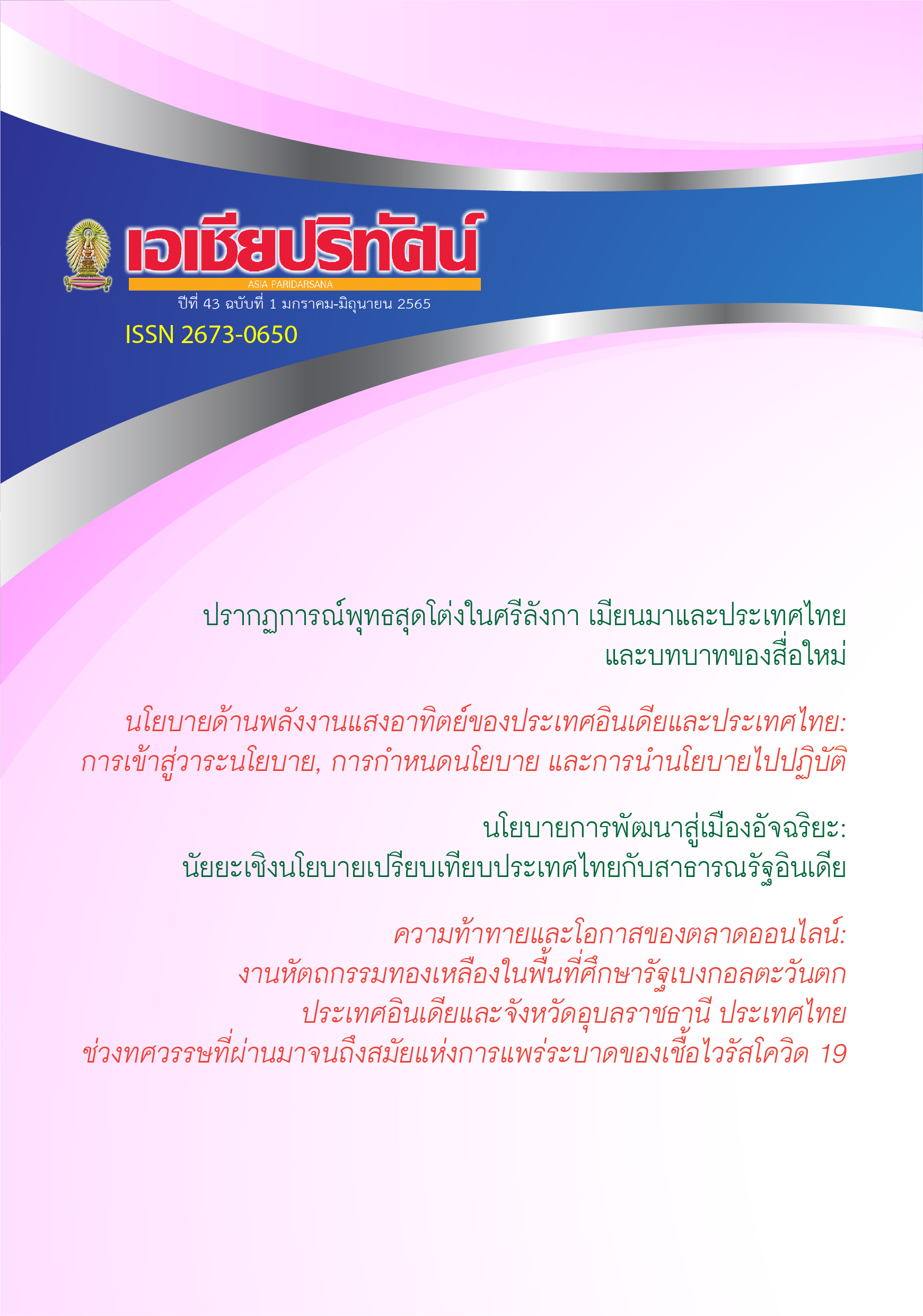Solar Energy Policies in India and Thailand: Agenda Setting, Policy Formulation and Policy Implementation
Main Article Content
Abstract
In this century, there have been significant new social movements focused on the minimisation of fossil fuel consumption to mitigate climate change at a global level. These have resulted in the making of public policies to support renewable energy (RE) production and deployment in many countries including India and Thailand. Both countries have had government organizations set up for RE policies in which solar energy policy is the major policy. Drawing from literature on solar energy policies in India and Thailand, this article discusses: (1) agenda setting; (2) policy formulation; and (3) policy implementation of solar energy policies in India and Thailand. It highlights how private sector and local actors have played an important role in implementing these policies. The article concludes with future directions for solar energy policies in Thailand.
Article Details

This work is licensed under a Creative Commons Attribution-NonCommercial-NoDerivatives 4.0 International License.
บทความทุกบทความเป็นลิขสิทธิ์ของสถาบันเอเชียศึกษา ดูตัวอย่างอื่นประกอบReferences
ภาษาไทย
กรมพัฒนาพลังงานทดแทนและอนุรักษ์พลังงาน. 2563. แผนพัฒนาพลังงานทดแทนและพลังงานทางเลือก
พ.ศ. 2561 – 2580 (AEDP 2018). กรุงเทพมหานคร: กระทรวงพลังงาน.
กรมพัฒนาพลังงานทดแทนและอนุรักษ์พลังงาน. 2564. “ยุทธศาสตร์พลังงานทดแทน.” กรมพัฒนาพลังงาน
ทดแทนและอนุรักษ์พลังงาน, 3 สิงหาคม 2564. https://www.dede.go.th/ewt_w3c/ewt_news.php?nid=646&filename=.
กระทรวงพลังงาน. 2562. “กระทรวงพลังงาน หารือร่วมกับผู้ประกอบการผลิตและจำหน่ายแผงโซล่าเซลล์
ส่งเสริมนโยบายการผลิตไฟฟ้าจากพลังงานแสงอาทิตย์.” กระทรวงพลังงาน, 2 มีนาคม 2565. https://energy.go.th/2015/กระทรวงพลังงาน-หารือร่ว/.
กองประสานการจัดการการเปลี่ยนแปลงสภาพภูมิอากาศ. 2563. “แผนที่นำทางการลดก๊าซเรือนกระจกของ
ประเทศปี พ.ศ. 2564-2573. สำนักงานนโยบายและแผนทรัพยากรธรรมชาติและสิ่งแวดล้อม กระทรวงทรัพยากรธรรมชาติและสิ่งแวดล้อม, 1 มีนาคม 2565. https://climate.onep.go.th/wp-content/uploads/2020/02/NDC-roadmap-infographic_F-1.pdf.
ณัฐณิชา ดอนสุวรรณ. 2564. “โครงการผลิตไฟฟ้าจากโซลาร์ฟาร์มในประเทศไทย ที่เดิมประกาศนโยบายหยุด
รับซื้อไฟฟ้าโครงการสุดท้ายไปเมื่อปี 2560 ล่าสุด 2 หน่วยงานรัฐ คือ "อีอีซี" และ "กองทัพบก" เตรียมผุดโปรเจคใหม่จ่อดึงเอกชนร่วมลงทุน.” กรุงเทพธุรกิจ, 3 สิงหาคม 2564. https://www.bangkokbiznews.com/news/detail/923509.
ณิชชา บูรณสิงห์. 2558. “เซลล์แสงอาทิตย์พลังงานทดแทนที่ยั่งยืน.” รัฐสภาไทย, 1 มีนาคม 2565.
https://web.parliament.go.th/view/7/nationalassembly/TH-TH.
ทีมงานหญ้าแห้งปากคอก (ท้องถิ่น). 2564. “โซลาร์เซลล์ดีแต่ต้องมีแผนที่เป็นรูปธรรม.” สยามรัฐออนไลน์, 2
มีนาคม 2565. https://siamrath.co.th/n/247997.
บริษัทบีซีพีจี จำกัด (มหาชน), 2564. “รู้จัก BCPG.” บริษัทบีซีพีจี จำกัด (มหาชน), 3 สิงหาคม 2564.
https://www.bcpggroup.com/th/about-us/bcpg-overview.
สำนักงานนโยบายและแผนทรัพยากรธรรมชาติและสิ่งแวดล้อม. 2559. “แผนที่นำทางการลดก๊าซเรือนกระจก
ของประเทศปี พ.ศ. 2564-2573.” กระทรวงทรัพยากรธรรมชาติและสิ่งแวดล้อม, 1 มีนาคม 2565.http://www.oic.go.th/FILEWEB/CABINFOCENTER38/DRAWER027/GENERAL/DATA0000/00000853.PDF.
สำนักงานนโยบายและแผนทรัพยากรธรรมชาติและสิ่งแวดล้อม. 2562. “แผนแม่บทรองรับการเปลี่ยนแปลง
สภาพภูมิอากาศ พ.ศ. 2558–2563.” กระทรวงทรัพยากรธรรมชาติและสิ่งแวดล้อม, 1 มีนาคม 2565. https://www.onep.go.th/book/แผนแม่บทรองรับการเปลี่/.
สำนักงานส่งเสริมการค้าในต่างประเทศ ณ เมืองเจนไน. 2559. “ธุรกิจพลังงานของอินเดียกับโอกาสของภาค
ธุรกิจไทย.” กรมส่งเสริมการค้าระหว่างประเทศ กระทรวงพาณิชย์, 1 กรกฎาคม 2564. https://www.ditp.go.th/contents_attach/152032/152032.pdf.
สุพัฒนพงษ์ พันธ์มีเชาว์. 2564. “พลังงาน-มหาดไทย เทงบ 2,400 ล้าน ดึงองค์กรปกครองท้องถิ่นลงทุน.”
ประชาชาติ, 3 สิงหาคม 2564. https://www.prachachat.net/economy/news-594332.
องค์การบริหารจัดการก๊าซเรือนกระจก (องค์การมหาชน). 2565. “NDC (Nationally Determined
Contribution).” องค์การบริหารจัดการก๊าซเรือนกระจก (องค์การมหาชน), 1 มีนาคม 2565. http://www.tgo.or.th/2020/index.php/th/page/ndc-nationally-determined-contribution-198.
Green Network. 2562. “ก. พลังงานแนะเอกชนผู้ผลิตโซลาร์เซลล์ เร่งลงทุนในประเทศ รับตลาดโต 20 ปี
ข้างหน้า รับไฟฟ้าเข้าระบบ 1.27 หมื่นเมกะวัตต์.” 3 สิงหาคม 2564. https://www.greennetworkthailand.com/ลงทุน-โซลาร์เซลล์-รับ20ปี/.
ภาษาต่างประเทศ
Blatter, J. 2013. “Glocalization.” Encyclopedia of Britannica, August 1.
https://www.britannica.com/topic/glocalization.
Chaudhary, A., Krishna, C. and Sagar, A. 2015. “Policy Making for Renewable Energy in India:
Lessons from Wind and Solar Power Sectors.” Climate Policy, 15(1): 58-87.
Council on Energy, Environment and Water (CEEW). 2021. “What are RPOs and RECs?” CEEW,
Graduate Center for Public Policy and Administration. 2002. “Public Policy Making as a
Process.” California State University Long Beach, March 1. https://home.csulb.edu/~msaintg/ppa590/intro.htm.
Janardhanan, N. K. 2017. “India’s Energy Policy: Energy Needs and Climate Change.” Institute
of Peace and Conflict Studies, August 1. http://www.jstor.org/stable/resrep09398.4.
India Brand Equity Foundation (IBEF). 2021. “Renewable Energy Industry in India.” India Brand Equity Foundation (IBEF), August 1. https://www.ibef.org/industry/renewable-energy.aspx.
King Abdullah Petroleum Studies and Research Center (KAPSARC). 2016. “Renewable energy
policy in India: Creation”, implementation and efficacy. Riyadh: KAPSARC.
Lan T.T., Techato K. and Jirakiattikul S. 2019. “The Challenge of Feed-In-Tariff (FIT) Policies
Applied to the Development of Electricity from Sustainable Resources: Lessons for Vietnam.” International Energy Journal. 19: 199 – 212.
Luomi, M. 2020. “The Global Governance of Sustainable Energy: Access and Sustainable
Transitions.” International Institute for Sustainable Development (IISD), August 1. https://www.iisd.org/articles/global-governance-sustainable-energy.
Madhusudan, M. D. and Vanak, A. T. 2022. “How India’s unguided quest for solar energy is
bringing about ecological and cultural erasure.” The Hindu, January 1. https://www.thehindu.com/sci-tech/energy-and-environment/how-indias-unguided-quest-for-solar-energy-is-bringing-about-ecological-and-cultural-erasure/article38077440.ece.
Ministry of New and Renewable Energy (MNRE). 2021. “Solar”. Ministry of New and Renewable
Energy (MNRE), August 1. https://mnre.gov.in/.
Piggot, G. 2017. “Will Social Movements Focused on Fossil Supply Help Solve the Climate
Crisis?” Stockholm Environment Institute (SEI), August 1. https://www.sei.org/perspectives/social-movements-fossil-fuel/.
Rajshekhar, M. 2021. “The Fall and Rise of Solar Costs in India.” The Wire, August 3.
https://thewire.in/energy/the-fall-and-rise-of-solar-costs-in-india.
Singh, P. 2020. “India’s Top 5 Power Producers and their Renewable Energy Plans.” Saur
Energy International, August 3. https://www.saurenergy.com/solar-energy-news/indias-top-5-power-producers-and-their-renewable-energy-plans.



